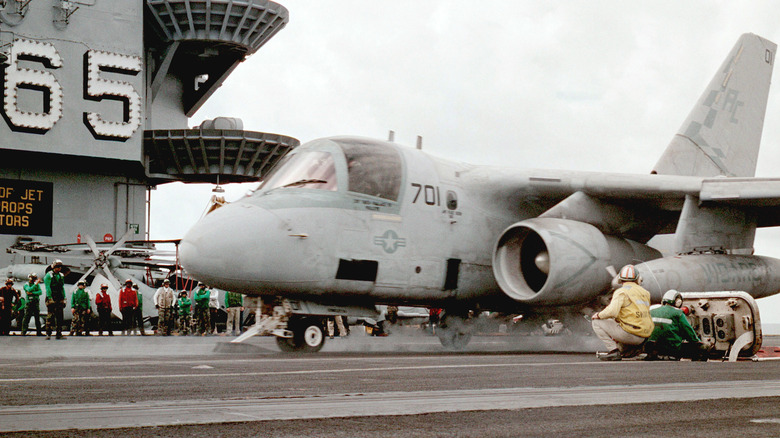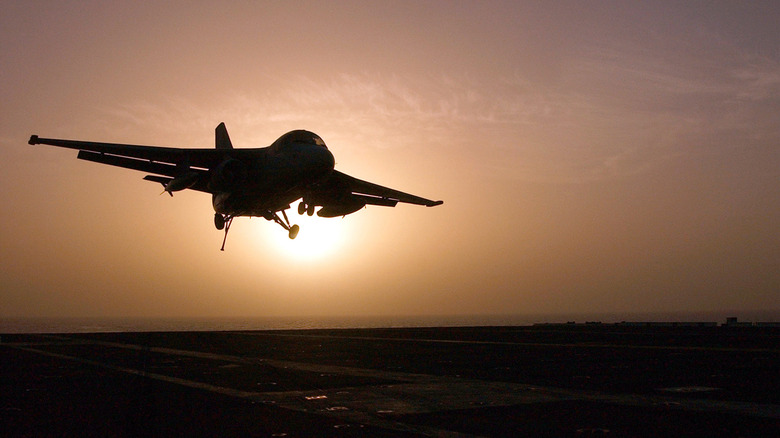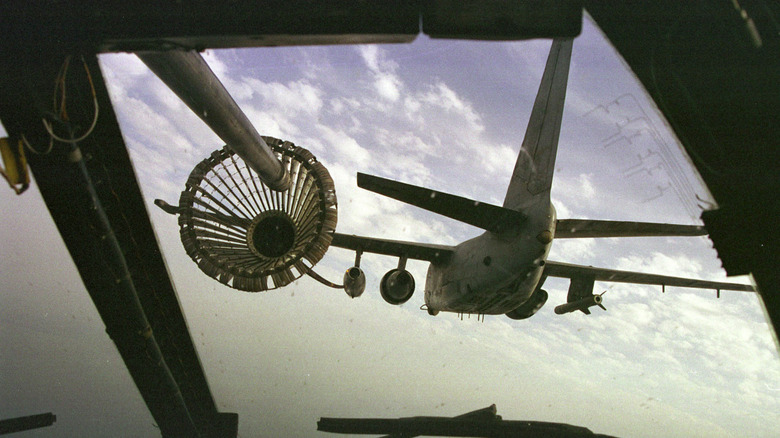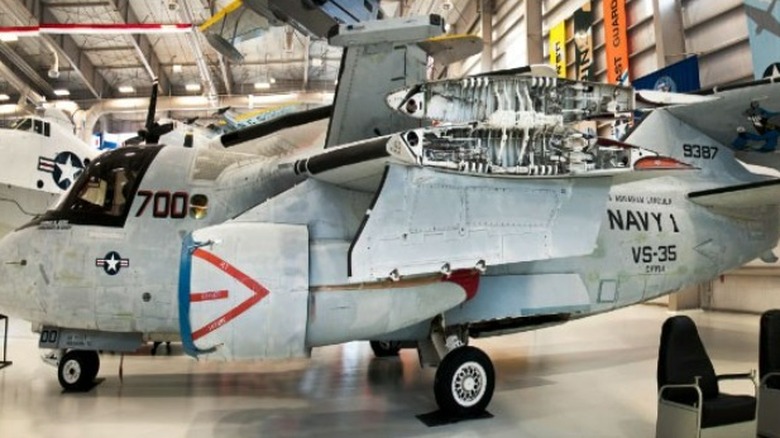The Versatile Navy Aircraft Designed To Hunt Underwater Prey
In September 1952, Joseph Stalin signed an order of the Soviet Union's Council of Ministers decreeing the construction of the nation's first nuclear submarine. Just three years later, on September 24, 1955, the first of its kind (K-3, known as "Leninsky Komsomol") was laid in Molotovsk and would participate in naval exercises for nearly 30 years afterward. This breakthrough by Soviet engineers heralded a new era of naval preparedness requirements for the United States. The threat of nuclear annihilation was a real one, yet for the first time, this threat (or a similarly destructive, non-nuclear bombardment) could be parked off the coast of an American city, reducing the time between a launch and subsequent detonation to mere seconds.
This fear, consequently, forms the basic premise of Tom Clancy's 1984 novel "The Hunt for Red October." Interestingly enough, in one shot in the 1990 movie adaptation, an S-3B Viking is present on the carrier's flight deck as Jack Ryan departs to link up with the Dallas. In the real world, as Soviet submarine capabilities continued to improve, the U.S. Navy realized a growing need to identify and track these silent stalkers beneath the waves. In February 1974, naval carriers got their answer to this growing problem in the form of the S-3A Viking. While the K-3 may have traversed the depths for nearly 30 years, so too did its American predator hunt in the skies. The S-3A (and later S-3B) were only retired from service in 2009, making them one of the American military's most effective and longest-used aircraft in the fleet.
Viking aircraft were deployed as a submarine scouting guardian
The S-3B and S-3A before it were rolled out as scouting vessels to replace the S-2 Grumman Tracker that had been in service since 1954. Their mission was to find and track Soviet submarines, as well as other small naval craft that may be hard to spot on the surface from a large aircraft carrier. The Viking aircraft were outfitted with radar and sonar systems, as well as magnetic anomaly detection (MAD) interfaces and sonobuoys. S-3A and S-3B planes were also outfitted with torpedoes and could therefore participate in an assault on a hostile submarine directly. As the front edge of the spear in anti-submarine operations, the Vikings were invaluable in protecting the lives of countless sailors throughout the Cold War and long after.
To fly a mission, one S-3 Viking would be crewed by three Navy fliers: A pilot and two naval flight officers who would operate the acoustic and non-acoustic sensor arrays, individually. The S-3 was flown using two 9,275-pound static thrust General Electric TF-43-GE-400B turbofan engines. The aircraft could fly as high as 40,900 feet above the ground and had a range of 2,645 miles. The aircraft could really move, too, reaching a maximum speed of 518 miles per hour at 25,000 feet (placing it within the same general capacity as a commercial jet flying 10,000 feet higher). These technical specifications made the S-3 Viking an integral component of anti-submarine warfare and aircraft carrier security.
The S-3B Viking also served as the Navy's primary overhead tanker
There were a total of 187 S-3As delivered to the Navy, and in 1987, 132 were upgraded to take on an expanded role. These revamped S-3 models were dubbed S-3Bs and saw improvements to the naval sensing equipment carried onboard as well as the weapons systems that were integrated into the aircraft. The S-3B Viking utilized improved Inverse/Synthetic Aperture Radar (ISAR/SAR), infrared sensors, and an Electronic Support System. Targeting and tracking were done through a combined human and computerized effort that made the Viking a fearsome adversary for submarines seeking to hide in the depths. Even so, the S-3 Viking never was called upon to engage in open warfare between the surface and a submarine beneath the fleet. The preparedness exhibited by the Navy through the armament of S-3s with AGM 84 Harpoon anti-ship missiles, AGM 65 Maverick IR missiles, torpedo and bomb armaments, and the AGM 84 Standoff Land Attack Missile Extended Range (SLAM-ER) nevertheless certainly contributed to this non-combat reality.
As the Cold War began to slow and eventually halt, the S-3B fleet was retrofitted once again to serve in a new role. When the Grumman A-6 Intruder was retired starting in the early 1990s (and retired completely in 1997), the S-3B Viking took its place as the primary overhead tanker to act in an aerial refueling capacity to support dynamic flight operations. The S-3B had always been a carrier aircraft and it thrived in this new capacity for many years.
The aircraft has also pulled duty in a variety of other ways
In addition to the submarine spotting and refueling capabilities that the S-3B Viking brought to naval combat readiness on the seas, it acted as a carrier onboard delivery platform and surveillance aircraft. The S-3B Viking was used extensively in combat missions over Iraq during the Abraham Lincoln aircraft carrier's ten-month deployment in the theater. Primarily utilized in the Pacific Fleet, the S-3B served as a stopgap for a wide range of necessities aboard carriers throughout the U.S. Navy. In addition, the lengthy deployment range of an S-3B Viking made it an excellent option for surveillance missions and targeting operations. These aircraft were, therefore, flown as part of precision-targeting runs and utilized in a revamped aerial hunter role, not unlike the initial submarine hunting purpose that the Viking was designed to achieve.
In the years since retiring from military service, the S-3B has found a new home as a research vessel for NASA, only exiting service in this additional refitting in 2021. "This old aircraft has been a huge part of ushering in the future of aviation," NASA's Command and Control project lead, Mike Jarrell said of the S-3B Viking.
This vessel was also deployed to bring President George W. Bush to the Abraham Lincoln to deliver his famous (or infamous) 'Mission Accomplished' speech. This made him the first President to trap aboard an aircraft carrier, and the S-3B Viking the "Navy One" aircraft to perform the function. The airplane that delivered him is now located in the National Naval Aviation Museum and naturally bears the insignia "Navy 1" between the wing and tail.



